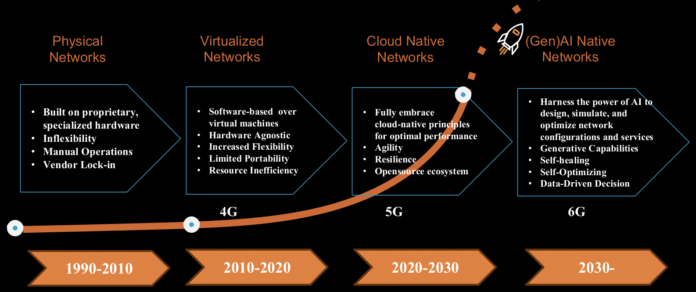Orange sees its cloud-native reinvention as setting the stage for the ultimate move to AI-native networking
As it relates to how telecom networks were built and operated, not much changed between 1990 and 2010; physical networks were (and some still are) built using specialized, proprietary hardware and were operated manually. The decade ending in 2020 was all about virtualizing networks using software running on virtual machines to increase flexibility. Now we’re on to cloud-native networks that leverage cloud computing principles to optimize performance using agile, resilient and open infrastructure. While AI-native networking is up next, Orange Innovation Networks Senior Project Manager and Research Ilhem Fajjari shared her perspective on the revolution that is the transition to a cloud-native telco.
Speaking during the Telco Cloud and Edge Forum (available on demand here), Fajjari called out a number of challenges operators will have to navigate as they move from the old to the new. She touched on integration of cloud-native solutions with legacy tech, an expertise shortage, security and regulatory compliance, managing multi-vendor complexity and the attendant push to interoperability, and aligning automation and orchestration efforts with operational efficiencies and improved user experience.
“To be able to achieve our cloud native transformation journey, as an operator we need to deal with challenges…A concrete implementation of our progress…it’s not magical. We need to go through several steps to be able to become really cloud native.”
Fajjari laid out a four-step process for implementing cloud native technologies and operations.
- Step 1: Adopt a lift and shift approach that leverages virtualization in the transition to cloud-native IT with an end goal of reducing complexity and avoiding vendor over-dependence.
- Step 2: Foster a collaborative culture that actively embraces and promotes cloud-native principles, while also making a significant investment in continuous development of workforce skills. That all includes taking a fail-fast approach.
- Step 3: Treat small scale experiments as testbeds for innovation, and allow for the exploration of new technologies in a controlled, manageable environment.
- Step 4: Forge new network supplier relationships while also strengthening collaborations with other operators.
Fajjari described a horizontal approach to multilevel automation that includes the network infrastructure and functions across all network domains, as well as orchestration of the end-to-end services. She noted the ability to effectively provide end-to-end service assurance, monitoring and quality as part and parcel of providing network slicing which many operators are billing as a potential revenue driver.
She also focused in on data observability as a primary foundation for network automation. However, Fajjari also acknowledged that “because we need to collect the metrics coming from heterogeneous equipment” across the radio, transport, core and IT domains, there’s an added complexity in the data collection that underlies observability.
Fajjari concluded her presentation with six best practices and principles to ease the transition to cloud-native telcos:
- Separate infrastructure and application lifecycles to increase agility and reduce complexity.
- Prioritize the use of APIs for network resource provisioning and management to enable automation and integration.
- Use intent-based, declarative automation over imperative workflows to streamline operations.
- Implement GitOps principles for network operations to ensure a single source of truth.
- Utilize unified consumption patterns, such as those provided by Kubernetes, to standardize resource management across different domains.
- Ensure interoperability through well-defined certification processes that encourage network equipment provider-agnostic solutions and prevent vendor lock-in. Foster an open ecosystem by adhering to standards and encouraging collaborative development across the industry.

